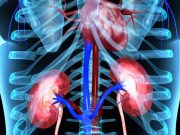Tag: DIAL
Higher Temperatures Tied to Greater Risk for Mortality in People Undergoing Dialysis
No association seen in patients with a kidney graft
Inpatient Dialysis Initiation Higher for Patients With CKD and Heart Failure
More frequent placement of central venous catheter seen for patients with heart failure with reduced ejection fraction
Study IDs Factors Linked to Risk for Transfer From Peritoneal Dialysis to Hemodialysis
Nurse-assisted peritoneal dialysis associated with lower risk for transfer to hemodialysis for infection in first 18 months
Denosumab Increases Cardiovascular Risk in Dialysis-Dependent Patients
Denosumab has greater preventive effect on fractures, but increased risk for MACE compared with oral bisphosphonates
Pain Coping Skills Training Beneficial During Maintenance Hemodialysis
Patients undergoing maintenance hemodialysis, experiencing chronic pain had larger reduction in BPI Interference score
Study Compares Single-, Double-Purse-String Suture Catheter Insertion Methods in Dialysis
Similar postinsertion complication rates and technical survival rates seen at one, two, and three years
Machine Learning Can Predict Intradialytic Hypotension During Hemodialysis
Various standard clinical variables measured by clinicians analyzed to determine scope of machine learning techniques in predicting IDH
ASN: Hypertension Most Common Cardiovascular Comorbidity Seen With Dialysis
The next most common conditions included atherosclerotic heart disease and congestive heart failure
Varying Dialysate Calcium Dosage Not Tied to Differences in All-Cause, Cardiovascular Mortality
Findings seen for 1.50 versus 1.25 mmol/L in patients undergoing hemodialysis
Study Looks at Impact of Peritoneal Dialysis on Thyroid Function
PD patients had higher T4 concentrations at baseline; higher FT4 concentration at 12 and 24 months than hemodialysis patients














